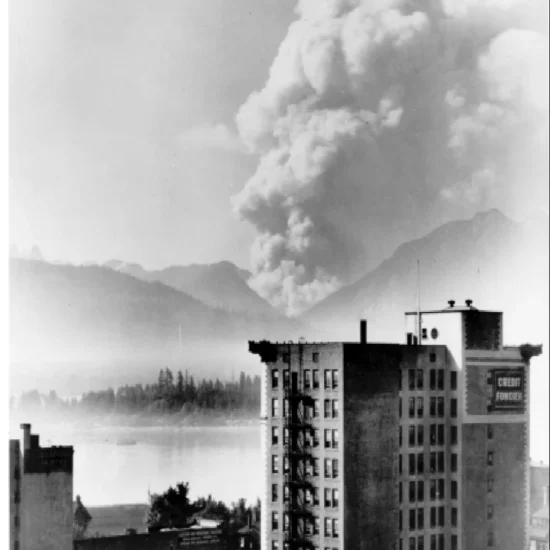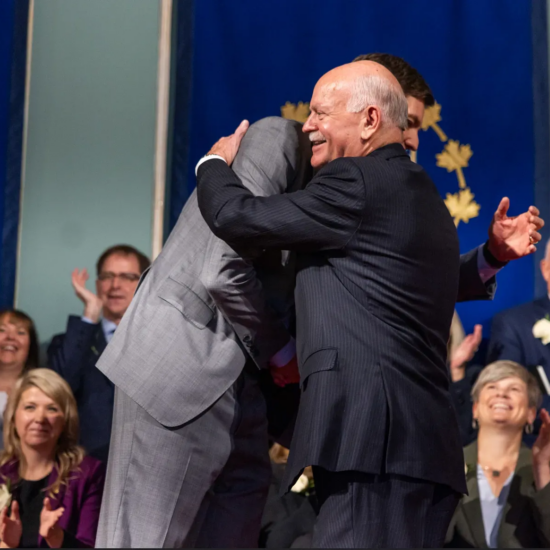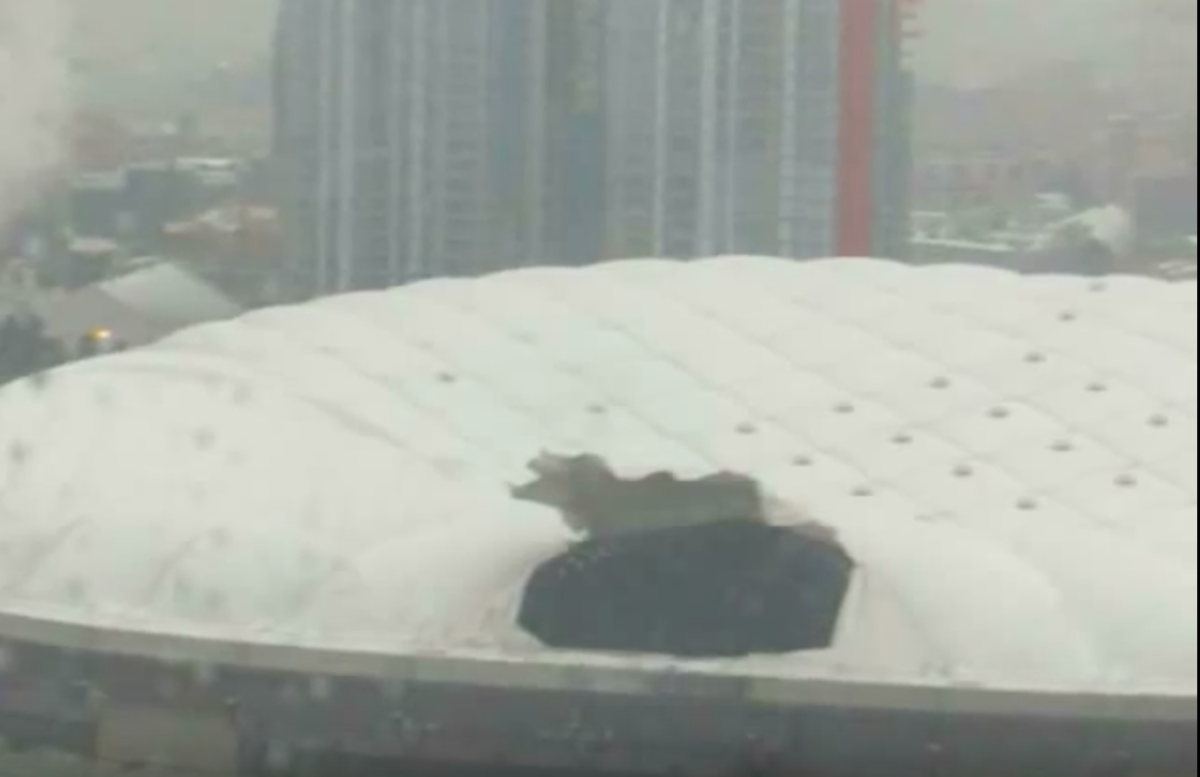
Bob Mackin
Where were you when the B.C. Place Stadium roof ripped and collapsed 15 years ago, after 12:33 p.m. on Jan. 5, 2007?
It was a cold day with occasional drizzle, even wet snow. I was at home, staying warm and dry, watching Canada beat Russia for the World Junior Hockey Championship on TSN. The phone rang. It was a friend that was not watching the game.
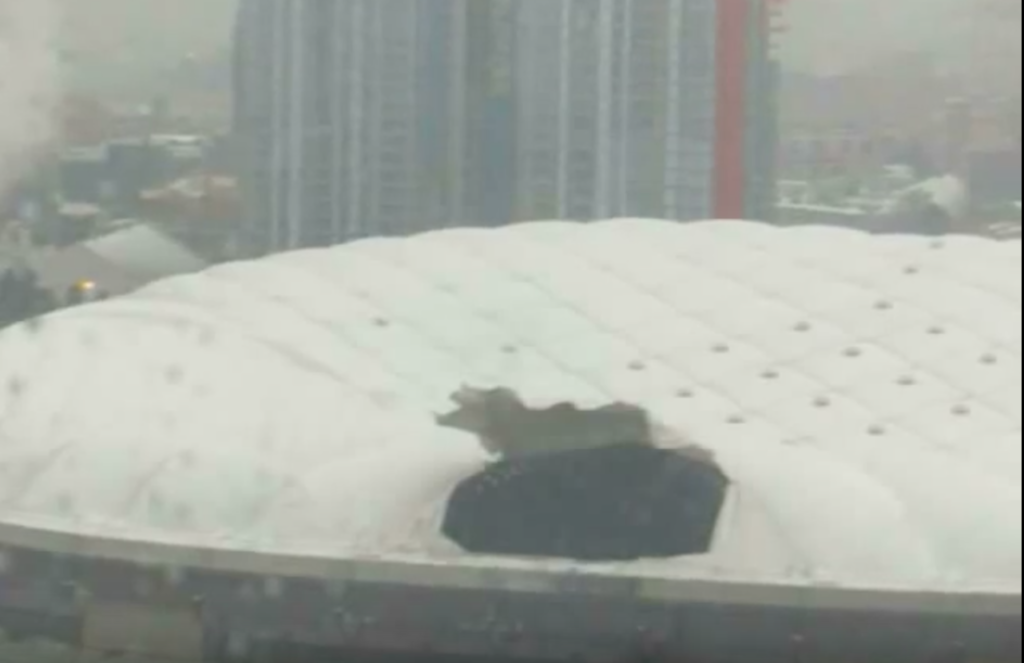
The hole cut in B.C. Place’s roof on Jan. 5, 2007.
“Quick, turn on CKNW! B.C. Place’s roof is down!”
So I did. It was true. Less than a minute later, I called my editor at 24 Hours Vancouver, Dean Broughton. We agreed to rush downtown to the stadium on our day off.
I also called a source who told me that the roof had numerous patches and that management had cut back on use of the snow-melting system to save money. The source gave me the phone number for the control room at the stadium. To my surprise, Linda Bilben from the stadium’s external public relations company, Reputations Corporation, answered and told me there would be a media briefing in an hour.
First, we went to the top of the Hampton Inn hotel on Beatty Street, which afforded us a view of the entire downed roof and the masses of snow, ice and slush strewn across the Teflon-coated Fibreglas surface. Then to the hastily called news conference at the east airlock door of the stadium. Reporters allowed were speechless as they gazed from a safe distance at the underside of the downed roof, the damaged lighting and sound equipment, and puddles of water and piles of snow.
Throughout the next week, B.C. Place management stubbornly and vainly claimed that it came down by way of a “controlled deflation” and that wind was to blame.
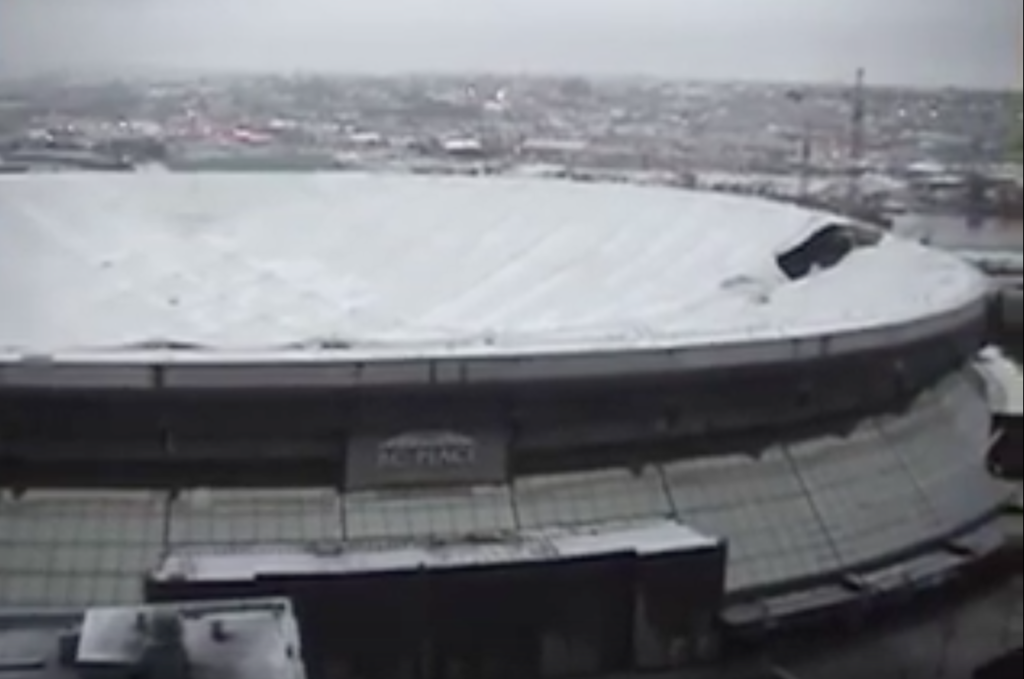
B.C. Place’s collapsed roof, as seen from the Hampton Inn.
Meanwhile, my source leaked internal documents that proved otherwise and delivered eyewitness accounts of what was really going on inside the stadium. For instance, stadium operations director Brian Griffin was spotted watching the World Junior hockey final on a TV in the lunchroom, unaware that the roof-hung speaker cluster was drooping toward field level.
What happened? In a nutshell, nobody activated the roof-heating system in the 1983-opened stadium.
Management should have learned a lesson at Christmastime 1996, when staffers were called in to urgently shovel snow from the roof. They earned special golf shirts to commemorate their role in saving the roof and preventing cancellation of the New Year’s Eve Three Tenors concert.
General manager Howard Crosley indicated in a sit-down interview with me a week later that cost was a reason for not turning on the roof heater. He claimed the roof was withstanding the weight of the snow, ice and slush. NDP critic Guy Gentner charged that preservation of annual executive bonuses at PavCo was really behind the penny pinching which put the public asset at risk.
The roof was patched and reinflated in two weeks. But the main ceremonies stadium for the next Winter Olympics in 2010 gained worldwide attention for the wrong reasons.
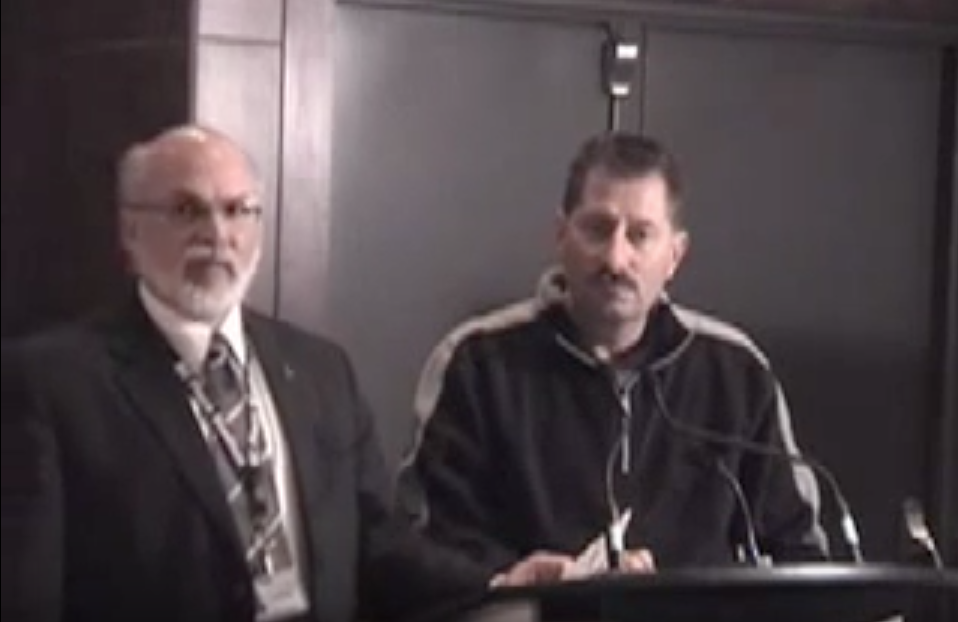
BC Place general manager Howard Crosley (left) and operations director Brian Griffin in January 2007.
Despite PavCo’s best efforts to spin the story, we reported the key facts:
Snow had been allowed to accumulate, the temperature fluctuated and five snow alarms were ignored. Nobody turned on the snow-melting system.
In the absence of heat, a control room worker spiked the interior air pressure. But that jolted the mass of snow, ice and slush, causing it to cascade on the west side of the roof where it sliced a gash in the roof and air rapidly escaped the building as the fabric roof violently flapped.
This was confirmed a year later when a report by Geiger Engineers and another by the stadium’s Joint Health and Safety Committee were released.
Bottom line, it was preventable.
It was a costly day for B.C. taxpayers
B.C. Place, the home of pro sports franchises owned by billionaires, got ahead of the line for capital funding before earthquake-prone St. Paul’s Hospital.
The stadium was eventually renovated and a new roof constructed for $514 million after the Olympics.
The roofing job was too big and too complex to be done before the Games. The entire cost was on the shoulders of taxpayers after elements of the financing came apart.
Cabinet scuttled the $40 million Telus naming rights deal in early 2012. The BC Liberal government had been under fire for handing a $1 billion, 10-year omnibus contract to Telus in June 2011 after abruptly halting a two-year bidding process on nine separate contracts. Bidders Bell, Rogers and Shaw threatened legal action. Bell is the Whitecaps’ main sponsor and the club’s owner, Greg Kerfoot, is a friend of Campbell’s successor, Premier Christy Clark.
In April 2011, Vancouver city council approved the relocation of Edgewater Casino from the Plaza of Nations to the parking lot on the stadium’s west side. But it refused to allow Las Vegas-based Paragon Gaming to double its slot machines in the new facility. So the agreed $6 million-a-year lease payments with PavCo were halved to $3 million in a 2013 renegotiation.
The Musqueam Indian Band later negotiated for a piece of the action and received $8.5 million of the first $9 million in revenue when the Parq Vancouver casino/hotel complex finally opened in 2017.
A decade and a half later, five elements of the incident and its legacy stand out.
The spin cycle:
PavCo’s PR company, Reputations Corporation, was quick on the scene Jan. 5, 2007. The company was responsible for the “controlled deflation” spin, which many media outlets wrongly took as gospel.
A quickie engineering report released a week later by Geiger Engineering, another PavCo contractor, put some of the blame on winds and the aging roof.
Winds were not a significant factor on the day. They peaked at around 20 km-h. Geiger corrected itself and completed its final report in October 2007.
Mysterious wish list:
In July of 2007, we learned that B.C. Pavilion Corporation had asked its parent ministry, Tourism, to fund major upgrades more than six months before the incident.
The building would host the Winter Olympics opening and closing ceremonies in February 2010 but was not scheduled for any significant modernization.
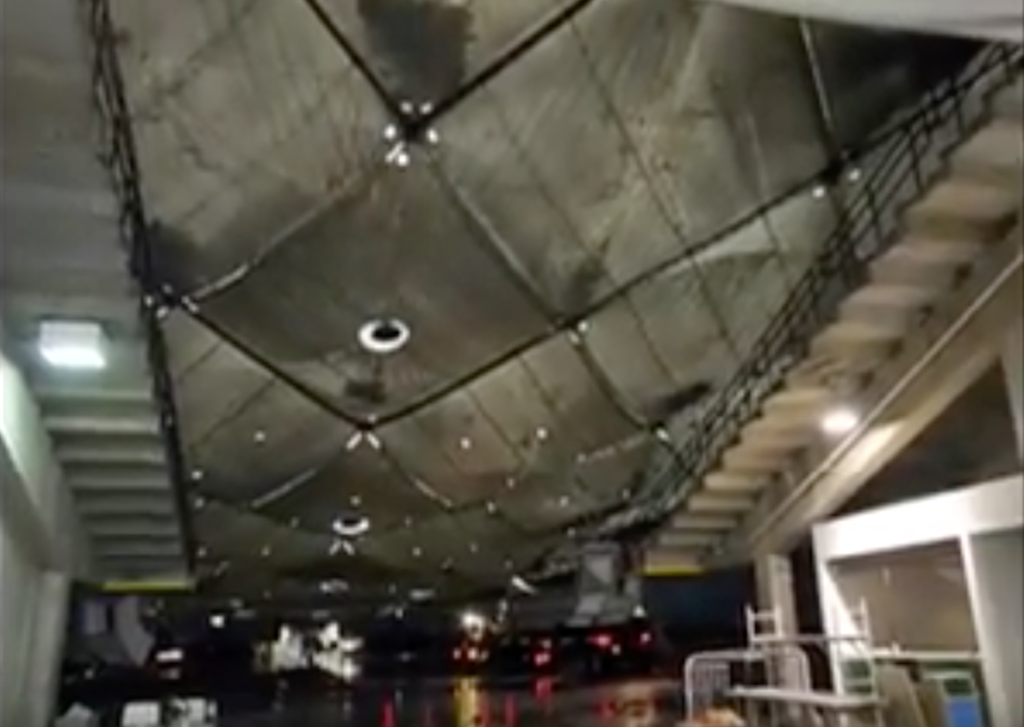
Inside B.C. Place, after the roof ripped and collapsed on Jan. 5, 2007.
Chad Skelton at the Vancouver Sun had unearthed the heavily censored “Infrastructure Improvements” report via FOI. Fourteen of the 15 pages were blacked out.
The June 20, 2006 report said the stadium had “worn out assets which are critical to basic tenant operations” and improvements were required to “bring it up to standards expected by clients and spectators at events.”
As Skelton reported, Minister Stan Hagen was “unavailable.” Hagen’s spokesman first claimed there was nothing in the report about the roof, and then changed his story to say he didn’t know what was in the report. Crosley refused to comment.
Promises broken:
Premier Gordon Campbell insisted that the renovation would require a business case approved by cabinet.
Campbell had come to power in 2001, vowing his BC Liberal government would never repeat the mistakes of the NDP’s Fast Ferries debacle. There would be evidence-based decision-making via business plans for every major project undertaken. His BC Liberals would also be the most open, accountable and democratic in Canada.
They failed that test.
My quest to get a copy of that business case and cost-benefit analysis for the renovation and roof replacement finally ended in failure in March 2016 when an adjudicator with the Office of the Information and Privacy Commissioner ruled that the documents were protected by cabinet confidentiality.
We do know that Burgess Cawley Sullivan & Associates was hired to review the 2010 to 2014 business plan for the stadium, but we don’t know how deep it went.
Did the consultants consider the impact of an aging population, the end of sports TV blackouts as we know them, the proliferation of high definition TV and desire for content on mobile devices?
All of those challenges have combined to cause major attendance declines for sporting events at the 2011-reopened B.C. Place. The Major League Soccer Whitecaps haven’t opened level 4 once after 10 seasons and the B.C. Lions closed level 4 in 2015.
Post-election sendoff:
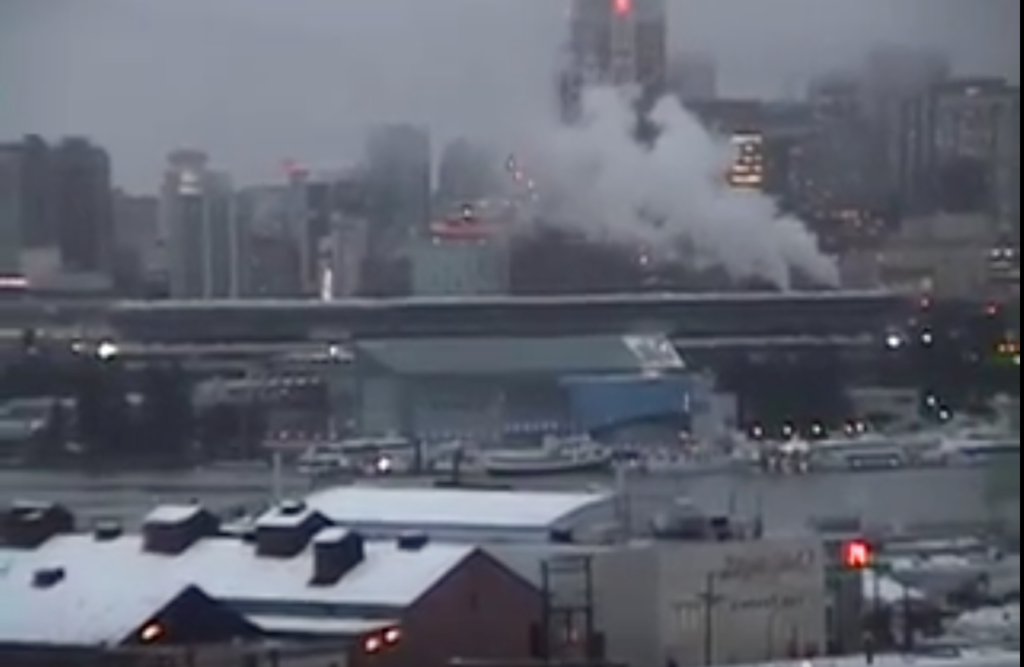
The skyline of Vancouver, after the B.C. Place roof ripped and collapsed Jan. 5, 2007.
Crosley and operations manager Brian Griffin both kept their jobs. Not only that, but they were key figures in the renovation project.
While Griffin remains employed at PavCo, Crosley was mysteriously fired the day after the 2013 provincial election (the surprise Liberal win) and sent packing with a nearly half-million-dollar golden parachute.
Why did that happen?
Audit avoided, documents destroyed:
Did taxpayers get value for their money?
We may never know.
In early 2013, with a provincial election looming, Auditor General John Doyle agreed to undertake a fact-finding mission after NDP critic Spencer Chandra Herbert complained. Chandra Herbert found a Jan. 22, 2008 letter from PavCo chair David Podmore to Vancouver’s city manager Judy Rogers. Podmore wrote that the cost would be “in the order of $100 million, which includes replacement of the roof.”
Rather than replace the inflatable roof, Podmore and co., with the Campbell cabinet’s blessing, decided on a German-engineered retractable system that would be built under a $365 million funding envelope announced in January 2009.
By the fall of 2009, the budget ballooned to $563 million.
After a power struggle with the BC Liberal government, Doyle went back to Australia without greenlighting an audit. (It would have required the contracting of external auditors, because B.C.’s auditor general is also the auditor for PavCo’s annual report).
Meanwhile, a whistleblower continues his quest to uncover details and seek accountability. John Hardy was an occupational first aid attendant from 2003 to 2009. He said he was fired for contacting PavCo’s insurer, Commonwealth Insurance, alleging that the Crown corporation collected a $7 million claim, despite failing to follow engineering guidelines, safe work procedures and structural warnings prescribed by roof engineer Geiger.
In late 2015, my source gave me a tip about a paper-shredding truck that pulled up to the stadium for an afternoon. PavCo was forced to admit to me under a freedom of information request that it paid nearly $1,700 for a company to destroy 403 bankers boxes full of files spanning 1983 to 2009.
They included operations and engineering work logs.
What would those documents have told us about the events of Jan. 5, 2007?
Support theBreaker.news for as low as $2 a month on Patreon. Find out how. Click here.
Bob Mackin’s 24 Hours Vancouver news report on Jan. 5, 2007
The Skonenblades video of the roof ripping and collapsing







